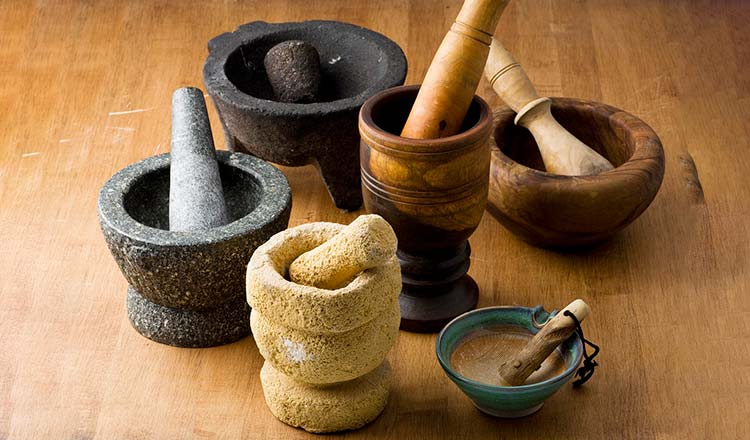The workhorse of the kitchen, the mortar and pestle is truly an indispensable tool. In many places, like southeast Asia, it’s particularly important because it’s used to make essential dipping sauces and bases. While a food processor may be used for small amounts of chili pastes, for example, it’s easier to pound a few chiles and garlic cloves in a mortar than to try and process them in a blender. This is true for small amounts of spices and other ingredients when even a small food processor is too large to accommodate the ingredients.
A mortar can be of any size and made from a number of materials, from the heavy, dense granite, marble, and brass to the more porous clay and wood. Most commonly available are the 4 ½-inch size, which is perfect for grinding small amounts of chiles and spices, and the 6½-inch size, which is a great all-purpose tool. The clay and wood varieties have deeper bowls and longer pestles, perfect for pounding fleshy ingredients and, if you cover the top of the mortar with your hands, you will not have juices squirting into your eyes. (This is important when pounding chiles and garlic.)
Pounding imparts a more intense flavor than chopping and mincing. In some cases, the pounding is about flavor as much as texture, since it bruises the flesh and releases the flavor in the skins, thereby making a dish quite distinctive. A mortar and pestle is also handy for grinding roasted nuts, seeds, and spices, as well as making meatballs, meat patés, and fresh herb sauces.
When using a stone mortar, hold the pestle and freely pound in an up-and-down motion. Many novice users make the mistake of pressing (as opposed to pounding) the pestle into the mortar, which makes the job much harder and longer. Once in a while, run the pestle in a circular motion against the sides to push the ingredients back into the center of the mortar. If you’re working with a long pestle and want to grind, hold the pestle with two hands. Firmly hold the top of the pestle with one hand and use the second to rotate the bottom of the pestle.
If you’re grinding hard spices, use this circular motion technique since it will give you a more fine, even texture. For best consistency, work with one ingredient at a time and start with the hardiest first. If you’re using hard spices, pound them first into a powder, then remove from the mortar and move on to other tough or fibrous ingredients. Fresh ingredients such as lemongrass and ginger should be chopped into small pieces before pounding, and dried chiles should be soaked in warm water until they become pliable, then torn into small pieces.
To make the pounding go faster and easier, and to pull the flavors of the ingredients together, add coarse salt or sugar, within the parameters of the recipe, to the mortar. This also helps to keep any juices from squirting into your eyes. Softer and wetter ingredients such as garlic and shallots can be placed in the mortar whole as they mash up relatively easily. When all the ingredients have been reduced to a powder or paste, put them back into the mortar and pound them together until they are well blended, or combine them in a larger bowl.
Every cuisine has its version of a mortar and pestle and the guidelines for using it depends on the cuisine, the tool, and the ingredients that need to be ground. For example, the Japanese ceramic mortar called suribachi works quite differently. A shallow bowl with a wide opening, it has an unglazed interior with rough, narrow groove patterns to facilitate grinding. This tool is especially great for sesame seeds that benefit from the gentler, circular motion grinding. In southern Indian cooking, a large, flat, and rectangular grinding stone, arrakallu, is used to grind herbs and spices. If you’re planning to cook Asian food regularly, you can start by investing in a small granite or stone mortar designated for spices and a larger one for all other ingredients. To clean, wash your mortar and pestle with soapy water and wipe dry.


